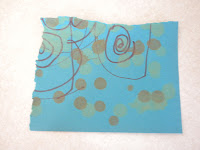Top of the Morning! With St. Patrick's Day coming up, start thinking about all the fun you can have with Pots of Gold, Leprechauns, Rainbows, etc.
Pick up or create a "pot" of lucky coins - I have a dollar store set of green and gold coins, but you can use anything you want - real coins, paper coins, whatever you have handy! Use these for counting games and for simple word problems ... "If I have 5 coins and I pay 4 for a toy, how many would I have left? If I have 2 coins, but I need five to get a cupcake, how many more do I need?" Even before children get the concept of coin values, they can simply count coins to get started.
Don't wait for written word problems to become "problems" for your children - get them used to the concept now by introducing them verbally. Then, turn the tables and have your child think up the problem next! This is great practice and using the coins gives them a visual, tactile aid to help them count. :)
Leprechauns might make visits to your home around St. Patrick's Day - watch out for furniture turned over or around, footprints and scattered lucky coins and shamrocks! Someone (with a Great Imagination) usually catches sight of an elf-like creature peeking in windows! Take turns removing an object from a room and having others guess what's missing - keeps them busy!!
Pick up or create a "pot" of lucky coins - I have a dollar store set of green and gold coins, but you can use anything you want - real coins, paper coins, whatever you have handy! Use these for counting games and for simple word problems ... "If I have 5 coins and I pay 4 for a toy, how many would I have left? If I have 2 coins, but I need five to get a cupcake, how many more do I need?" Even before children get the concept of coin values, they can simply count coins to get started.
Don't wait for written word problems to become "problems" for your children - get them used to the concept now by introducing them verbally. Then, turn the tables and have your child think up the problem next! This is great practice and using the coins gives them a visual, tactile aid to help them count. :)
Leprechauns might make visits to your home around St. Patrick's Day - watch out for furniture turned over or around, footprints and scattered lucky coins and shamrocks! Someone (with a Great Imagination) usually catches sight of an elf-like creature peeking in windows! Take turns removing an object from a room and having others guess what's missing - keeps them busy!!
You might want to make leprechaun-scopes to focus the search. Paper towel rolls covered with paper and decorated with coloring or stickers make a fun project for searching around - and maybe a game of I Spy!
For another art project, make rainbows with tissue paper and construction paper scraps - remember ROY G BIV (red, orange, yellow, green, blue, indigo, violet) - it's fun and helps reinforce color naming, small motor skills, and use of materials. A little gold glitter will look great and add interest spilling out of a U shaped pot of gold :) Try making a model and having your child try to copy it - shaping, sizing, and cutting are great skills!
For another art project, make rainbows with tissue paper and construction paper scraps - remember ROY G BIV (red, orange, yellow, green, blue, indigo, violet) - it's fun and helps reinforce color naming, small motor skills, and use of materials. A little gold glitter will look great and add interest spilling out of a U shaped pot of gold :) Try making a model and having your child try to copy it - shaping, sizing, and cutting are great skills!
Create Shamrocks by breaking them down into shapes - three hearts and a stem in a shamrock, four hearts in a four-leaf clover - find or make a heart shaped sponge or stamp and you can make tons of them! This works for other things, too - deconstructing objects into the shapes that make them up will help your child visualize things they want to draw!
Have fun!
Have fun!



























